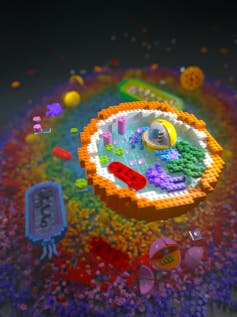Modern physics can explain everything from the spin of the tiniest particle to the behaviour of entire galaxy clusters. But it can’t explain life. There’s simply no formula to explain the difference between a living lump of matter and a dead one. Life seems to just mysteriously “emerge” from non-living parts, such as elementary particles.
Assembly theory is a bold new approach to explaining life on a fundamental scale, with its framework recently published in Nature. It assumes that complexity and information (such as DNA) are at the heart of it. The theory provides a a way to understand how these concepts emerge in chemical systems.
Emergence is a word physicists use to explain something that is bigger than the sum of its parts – such as how water can feel wet when individual water molecules don’t. Wetness is an emergent property.
While the mathematics is elegant, the theory can ultimately only be reliable if it is tested in the lab. Carefully designed experiments, such as the one my colleagues and I are carrying out right now, will be essential to ground the abstractions of assembly theory in chemical reality.
At the core of assembly theory is the idea that objects can be defined not as immutable entities, but by the history of how they formed. This shifts focus to the processes by which complex configurations are constructed from simpler building blocks.

The theory proposes an “assembly index” which quantifies the minimal steps, or shortest path, required to build an object. This measure tracks the degree of “selection” necessary to yield an ensemble of objects – referring to the memory, such as DNA, required to create living things.
Living things, after all, don’t just occur spontaneously, such as helium in stars. They require DNA as a blueprint for creating new versions.
Predictions of novelty
But how might these theoretical constructs actually be probed experimentally? One key aspect of assembly theory has already been tested in our lab. That is the determination of the assembly index using mass spectrometry (an analytical tool which can measure the mass-to-charge ratio in molecules).
By fragmenting molecules and analysing their mass spectra, we can estimate their assembly index. We can literally see how many steps it takes for various fragments to piece together to form a given molecule. Assembly index can also be measured using other techniques called infrared spectroscopy and NMR spectroscopy for various types of molecules.
We’ve determined the assembly index on a range of molecules, both in the lab and computationally. Our work shows that molecules associated with life, such as hormones and metabolites (products of metabolic reactions), are indeed more complex and require more information to assemble than molecules that are not uniquely associated with life, such as carbon dioxide. In fact, we’ve shown that an assembly index above 15 steps is only found in molecules associated with life – just as the theory suggests.
The theory also offers testable insights into the origin of life. That’s because it says there’s a point at which molecules become so complex that they start using information to make copies of themselves – suddenly requiring memory and information – a sort of threshold at which life arises from non-life.
Ultimately, it is possible to have selection and minimal memory in non-biological systems (such as how our Sun formed the planets by pulling together a ton of mass). But you can’t get living organisms or the technology they create – be that lego or rocket science – without high levels of memory and selection.
Chemical soup
We are planning to investigate this origin of life more closely by creating a type of chemical soup in our lab. In this soup, brand new molecules could be created over time, either by adding various reactants or by chance, while we monitor their assembly index and growth of the system. By tuning reaction rates and conditions, we could study that fascinating transition point from non-life to life – and learn whether it follows the predictions made by assembly theory.
We are also designing “chemical soup generators”, which mix together simple chemicals to find complex ones. These may boost our understanding of how complexity can be built using assembly theory and how selection outside of biology can be initiated.
This could uncover something about how life first evolved, starting with minimal selection and then requiring more and more. Under identical conditions, are objects constructed in predictable ways? Or does randomness enter the fray at some point? This would help us understand whether the emergence of life is deterministic and predictable, or more chaotic.

This means assembly theory could apply much more broadly. Beyond molecules, the framework could inspire studies on other systems that rely on combinations, such as material aggregates, polymers or artificial chemistry. This may lead to new scientific insights or technological inventions. It may reveal subtle patterns whereby molecules above a threshold assembly index disproportionately possess certain properties.
We could also use the theory for detailed studies of evolution itself. Research could explore how fragments of cells exist in the process of forming an overall cell, arising from smaller molecules combining to form amino acids and nucleotides. Tracking the emergence of metabolic and genetic networks in this way may offer clues into transitions in evolutionary history.
Experimental tests pose challenges, however. Tracking how objects are assembled demands precise experimental monitoring.
But it might be well worth it. Assembly theory promises a radically new understanding of matter – potentially uncovering universal principles of hierarchical construction that transcend biology.
Complex configurations of matter may not be immutable objects, but waypoints in an open-ended process of construction propagating through time. The universe may obey certain physical laws, but it is ultimately creative.


